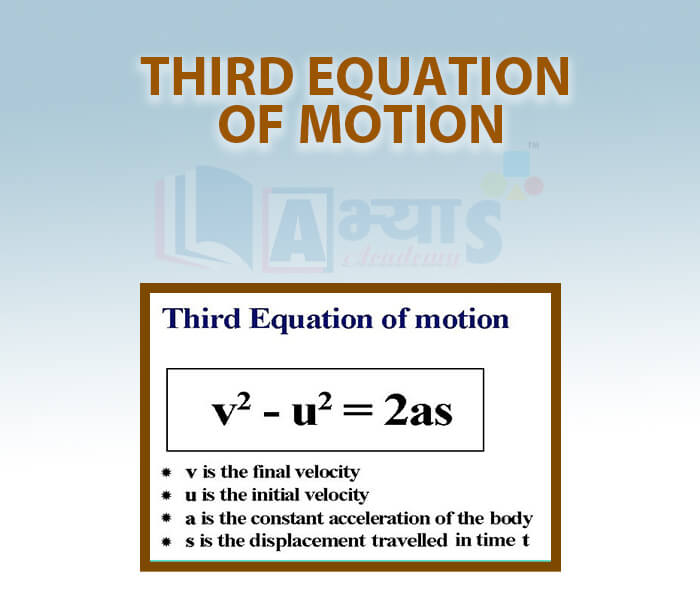Third Equation of Motion










Third Equation of Motion
THIRD EQUATION OF MOTION:
v= Final Velocity
u = Initial Velocity
a= Acceleration
s= Distance
Let us derive the third equation of motion
Distance travelled=average velocity X time
(I)
But from the first equation of motion, v = u + at
Substituting the value of t in Eq (I)
or
Example: A car is moving with an initial velocity of 5 m/s . The final velocity is 25 m/s when it accelerates at thr rate of 6 m/sq. s. Find the distance travelled
Sol: u = 5 m/s
v= 25 m/s
a = 6 m/sq. s
s = ?
(25+5)(25-50 = 12 s
30 X 20 = 12 s
600 = 12 s
The three equations listed can be used to solve the majority of kinematic problems.
The speed of a car reduces from | |||
| Right Option : A | |||
| View Explanation | |||
A body with an initial velocity of 36 km/h accelerates uniformly at the rate of 18 cm | |||
| Right Option : A | |||
| View Explanation | |||
The speed of a car reduces from | |||
| Right Option : A | |||
| View Explanation | |||
Students / Parents Reviews [10]
My experience was very good with Abhyas academy. I am studying here from 6th class and I am satisfied by its results in my life. I improved a lot here ahead of school syllabus.

Ayan Ghosh
8thAbout Abhyas metholodology the teachers are very nice and hardworking toward students.The Centre Head Mrs Anu Sethi is also a brilliant teacher.Abhyas has taught me how to overcome problems and has always taken my doubts and suppoeted me.

Shreya Shrivastava
8thAbhyas Methodology is very good. It is based on according to student and each child manages accordingly to its properly. Methodology has improved the abilities of students to shine them in future.

Manish Kumar
10thBeing a parent, I saw my daughter improvement in her studies by seeing a good result in all day to day compititive exam TMO, NSO, IEO etc and as well as studies. I have got a fruitful result from my daughter.

Prisha Gupta
8thAbhyas is a complete education Institute. Here extreme care is taken by teacher with the help of regular exam. Extra classes also conducted by the institute, if the student is weak.

Om Umang
10thIt was good as the experience because as we had come here we had been improved in a such envirnment created here.Extra is taught which is beneficial for future.

Eshan Arora
8thMy experience with Abhyas is very good. I have learnt many things here like vedic maths and reasoning also. Teachers here first take our doubts and then there are assignments to verify our weak points.

Shivam Rana
7thIt has a great methodology. Students here can get analysis to their test quickly.We can learn easily through PPTs and the testing methods are good. We know that where we have to practice

Barkha Arora
10thMy experience with Abhyas academy is very good. I did not think that my every subject coming here will be so strong. The main thing is that the online tests had made me learn here more things.

Hiya Gupta
8thIt was a good experience with Abhyas Academy. I even faced problems in starting but slowly and steadily overcomed. Especially reasoning classes helped me a lot.
